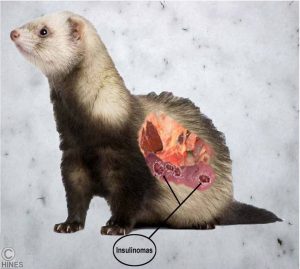 What Are Insulinomas And How Will They Affect My Ferret?
What Are Insulinomas And How Will They Affect My Ferret?
Insulin-producing tumors (insulinomas) of the pancreas are more common in ferrets than they are in our other common pets. Ferrets over the age of five are the ones most susceptible to these tumors. They can appear as a single small lump within your ferret’s pancreas or as many smaller nodules. The arrows I drew in my imaginary photo above point to two of them; but the actual size of the pancreas is larger than it would be in real life.
Your ferret’s pancreas has two functions – the same ones that your pancreas has. It supplies some of the enzymes you need to digest food and it supplies the hormone, insulin that regulates your blood sugar level. The portions that malfunction in insulinoma are the ones that produce insulin. Those portions of the pancreas are called the islets.The groups of cells in the islets that produce insulin are called beta cells. When some of these beta cells begin to multiply out of control, they produce more insulin than your ferret’s body needs or wants. These abnormal beta cells eventually form raised lumps or nodules in your ferret’s pancreas.
Most ferret owners already know allot about insulin because the lack of it, diabetes, is so common in us humans. In ferrets with insulinoma, exactly the opposite occurs. Instead of not enough insulin, too much insulin is produced. That causes your pet’s blood sugar levels to drop dangerously low (= hypoglycemia).
Ferrets develop insulinomas between 2 and 7 years of age, but most tend to be 5 years or older when insulinoma signs begin to occur. Those who have studied large numbers of ferrets believe that approximately 20-25% of ferrets will develop insulinomas during their lifetime.
I believe that the true prevalence of insulinomas is probably considerably greater than that because many older ferrets lack symptoms when the tumors are present but small. Also a few types of insulinomas do not secrete insulin. And in some ferrets, areas of their pancreas are “pre-cancerous” (hyperplastic) but have not progressed to the functional cancerous state we call insulinoma. That is why finding evidence of small insulinomas in ferrets that died from a variety of other causes is quite common.
 Do Veterinarians Know Why Ferrets Develop Insulinomas So Frequently?
Do Veterinarians Know Why Ferrets Develop Insulinomas So Frequently?
We have our suspicions. Many veterinarians and ferret breeders assume that it has to do with the diets we commonly feed our pet ferrets. The pancreas is intimately involved in the processing and disposition of nutrients and we know that wild ferrets were designed to subsist on the meat of prey alone. Most ferret owners in the United States feed their pets dry kibble for convenience sake. To produce a kibble product, the companies need a binder. That binder has traditionally been a carbohydrate (starchy) ingredient such as corn, wheat, potato or peas. Carbohydrates are also cheaper than quality meat ingredients. It is also common for ferret owners in North America to give their ferrets non-meat, high carbohydrate treats. Wild European ferrets (polecats) consume a diet of rodents that consist of approximately 50% protein and 28% fat and very minimal carbohydrate. Rodent flesh is about 80% water. It is quite low in fiber. To my knowledge, insulinomas have not been reported in them. However few of these animals survive in the wild over 5-7 years due to the inherent dangers of wild living. We do not know if pancreatic tumors might have appeared had they lived longer.
Some point to the fact that native American black footed ferrets that also live on rodents, have no recorded insulinomas. But their average life span is also considerably shorter than domestic ferrets and perhaps they just do not live long enough to develop them.
Some state that diet must be a factor because it is said that European and UK ferrets develop insulinomas less frequently than in America and that in Europe and the UK, ferrets have traditionally be fed a diet of meat. However there is no proof that it is diet that accounts for that. European and UK ferrets also tend to get more hunting exercise, are often housed outside and are generally not neutered or spayed at the very young age that we in America do. Ferrets are in the mustela family. So are their cousins, mink and otters. Ranched mink and zoo otters are provided diets that generally provide a minimum of 38% animal protein and a minimum of 20% animal fat. Most receive diets that are considerably higher in animal protein content. I know of no known reports of insulinomas in either species. Perhaps that points toward diet as a contributing factor to insulinoma in ferrets as well. Another factor could be how you present your ferret’s food. All mustela are nibblers. In nature they never consume large meals. Large meals make the pancreas work harder; and perhaps it just wasn’t designed to do that. But others theorize that defective genes, similar to those occurring in “MEN” may play a part as well. (rptref) There is no science that confirms or refutes that, that I know of.
 What Symptoms Might I See If My Ferret Develops Insulinomas?
What Symptoms Might I See If My Ferret Develops Insulinomas?
In the early stages of insulinoma disease signs are not specific. They can also be easy overlooked. Periodically, your ferret might look like it was preoccupied or uncharacteristically inactive and deep in thought (star gazing).
Healthy ferrets rarely sit still unless they are asleep. We think this appearance of contemplation might be an early sign of low blood sugar. And because insulin release naturally increases after meals, these early signs sometimes relate to a recent meal. In other cases, it appears to be just the opposite, perhaps because a recent meal liberates enough liver-generated glucose to decrease low blood sugar symptoms. The inability to think clearly is one of the first signs of hypoglycemia in humans, Perhaps something similar happens in ferrets as well.
As the tumorous pancreas islets enlarge and secrete more and more insulin, troubling signs become worse. Ferrets usually become less active than they traditionally were. They tend to loose their appetite and consequently loose weight. Some vomit or drool, others experience diarrhea and/or seem uncomfortable around their mouth. Some believe that this is due to nausea. With time, it is very common for these ferrets to drag their rear legs (I mention in several of my other articles that there are many conditions besides insulinoma that cause rear leg weakness in ferrets).
In advanced insulinoma cases, the ferret’s blood sugar level sometimes drops so low (due to its abnormally high insulin level) that the pet develops twitching, staggering (ataxia) and seizures (Again, regarding ataxia, a healthy ferrets gait is never graceful). Left untreated, some of these low-blood-sugar-ferrets will eventually lapse into a coma and die. Often, it is about the time that the ferret begins having trouble walking that it is finally brought to a veterinarian. I mention frequently that ferrets age considerably more rapidly than dogs and cats. Aging ferrets are also quite prone to tumors in their endocrine glands other than their pancreas (such as adrenal tumors) and to develop lymphoma, intestinal and heart disease. So by the time your veterinarian is brought into the picture, do not be surprised if she/he finds that your ferret is dealing with several chronic health issues – particularly if it is over 5 years old.

The most direct test is to measure your ferrets fasting blood glucose level. That means that blood must be obtained from your pet 4 + hours after its last meal. There are differences of opinion as to what the normal fasting blood sugar level of ferrets should be. Normal ferrets have a fasting blood glucose level of between 80-120mg/dl. Anything under 60-70 is very likely evidence that the pet has insulinomas. Anything under 85 is suspicious enough to run the test again. Fasting must be done with care and under close veterinary observation because these sick pets are frail.
Once an abnormally low blood glucose level has been confirmed, your veterinarian will likely order several additional blood tests. They are included in what we called a standard blood chemistry panel. Pretty much the same thing you and your other pets get on yearly physicals.
The first group of blood tests checks the health of major organs. These tests need to be run because on occasion, liver disease will also lower blood glucose levels. It is your pet’s liver that provides reserve glucose sugar through the conversion of liver glycogen. Rarer possible causes of low blood glucose in ferrets are heatstroke or starvation.
Another reason for a general blood chemistry panel and CBC is that it is rare, as I mentioned, for a ferret to develop insulinomas without having other organ problems going on as well. Those other screening tests also rule out a severe infection that might also account for low blood glucose. Depending on the preferences and practice style of your veterinarian, he/she might also suggest x-rays to evaluate your ferret’s heart, a urine examination to evaluate its kidneys and an ultrasound examination to screen for evidence of cancer, heart disease, etc. As time goes by, veterinarians rely more and more on ultrasound – although both ultrasound and x-rays often fail to detect insulinomas when they are small to moderate in size. These additional tests are a wise idea if you and your veterinarian are contemplating a surgical option to deal with its insulinomas. They are less urgent if you are not. Your veterinarian’s diagnosis of insulinoma is further confirmed when a ferret with weakness and neurological problems improves shortly after being given an intravenous injection of glucose.
It is also a valid option for your veterinarian to perform exploratory surgery on suspect ferrets to confirm that the characteristic reddish-brown firm nodules of insulinoma are present in the pancreas. With insulinomas, these nodules can be present in its surrounding tissue (mesenteries) as well. Most veterinarians would attempt to remove as many of these nodules as they could before the surgery was completed. When additional confirmation is desired, a portion of a nodule(s) can be submitted for a pathologist’s review.
 Emergency Treatment For The Hypoglycemia Associated With Insulinoma
Emergency Treatment For The Hypoglycemia Associated With Insulinoma
Many ferrets suffering from insulinomas are rushed to their veterinarian in hypoglycemic shock. The symptoms and treatment are similar to those seen in diabetic humans who received too large a dose of insulin. (read here) These ferrets are presented in a state of collapse, often with intermittent seizures.
Their preferred treatment is a slow intravenous infusion of dextrose solution. Dextrose and glucose are biochemically identical. At the same time, a corticosteroid, usually dexamethasone, is infused to counter insulin rebound. If seizures persist, an anti-seizure medication (eg diazepam, midazolam) might be required. Some veterinarians have attempted to give these ferrets diazoxide, a compound used to inhibit insulin secretion in humans, but with mixed success. As soon as the ferret is willing to eat, small high-protein meals, given at short intervals are advisable to keep its blood glucose levels at normal levels. Some insulinoma ferrets benefit from an oral corticosteroid/broth solution mixed into their meals or given by dropper twice a day.
 What Long-term Treatment Options Are Available For My Ferret?
What Long-term Treatment Options Are Available For My Ferret?
Your veterinarian can suggest medications and diet modifications or surgery – often all three.
 Managing Insulinomas With Medications:
Managing Insulinomas With Medications:
Some ferrets with insulinomas can be stabilized with medications and dietary management alone. This does not cure or slow the progress of insulinoma. But in many cases medications keep the pet’s blood glucose levels stabilized for a substantial period of time with the potential of only an occasional mild hypoglycemic crisis now and then. Insulinoma is a progressive disease. So as time goes by, management with medications alone and with diet modifications become less and less effective.
Medical management almost always includes a corticosteroid (eg prednisone, prednisolone, dexamethasone, etc.) to stimulate your ferret to synthesize more blood glucose (gluconeogenesis). That counteracts the effects of the insulin being produced by the insulinomas. Like cats, ferrets appear less likely to develop the common side effects of corticosteroids that we see in dogs and humans. (read here) If unmanageable steroid side effects do occur, diazoxide is still an alternative. It can be tried as a substitute or as an additional medication that allows the pet’s corticosteroid dose to be lowered to a point where side effects are tolerable. There have really been no controlled studies that compare the success of medicational and dietary treatment of insulinoma in ferrets to the success of surgical treatments. Few ferret owners would consent to their pet being used in such a study and most ferrets that are treated surgically still receive medications and dietary treatment after their surgery.
 Is A Surgical Option Right For My Ferret With Insulinoma?
Is A Surgical Option Right For My Ferret With Insulinoma?
Your veterinarian will probably bring up a surgical treatment option. He/she can remove as many visible insulinomas in your ferret’s pancreas and surrounding tissue as is possible. Sometimes that is presented as part of a diagnostic option – do the surgery on a suspected case of insulinoma, identify them in the pancreas when present and why not remove as many as possible while they are there. The term often used is “debulking”. In the process of debulking, it is common for enough surrounding and normal-appearing pancreatic tissue to be removed to in itself lower blood insulin levels. Too much removed and diabetes is a possibility. The age of your ferret as well as the common concurrent diseases associated with aging ferrets are my primary concern when suggesting this surgery. Remember, ferrets naturally have lifespans considerably shorter than dogs and cats. As they age they always face a variety of degenerative health issues. So removing insulinomas will not necessarily lead to a longer life for your ferret. Surgery is not a cure – at best, consider it a temporary reprieve. Another question most of us need to ask is “can my family afford the cost of this surgery and follow up care. How will it affect my other pets? How will it affect my work schedule? How will it affect my relationships? Don’t be ashamed to ask. And disregard hard sell or insinuations of guilt for deciding not to. Ask yourself if surgery for a treasured ferret that is elderly and/or has multiple health issues is really a humane and kind thing to do.
Most ferrets that undergo insulinoma surgery still need to receive lifelong medications. Subsequent to the surgery, the pet’s blood glucose level needs to be monitored periodically.
 What can I Expect after Surgery?
What can I Expect after Surgery?
Most ferrets recover well from this surgery. They are usually up and about quite quickly and their blood sugar value usually rises almost immediately. Check your pet’s surgical incision site frequently to be sure it remains well closed and keep the pet from burrowing into sheets and bedding so that you can closely monitor its condition. Be sure it is eating, pooping and urinating regularly. When in doubt, call your vet’s nurse.
An occasional ferret will develop abnormally high post-surgical blood sugar levels, but these usually return to normal by themselves as the pancreas adjusts to new realities. A few others go on to develop diabetes when too much pancreatic tissue had to be removed.
However, it is not uncommon for blood sugar levels to begin to dip again in your ferret 6-9 months after surgery. These ferrets will need their treatment continued medically. A second (or third) surgery is an option – but one I do not often advise. The best way to monitor your ferret’s long-term post-surgical pancreatic health or its health during medical treatment is with periodic blood sugar testing. This is something you can and should do at home.
 From Now On Will It Be Important What and When I Feed My Ferret?
From Now On Will It Be Important What and When I Feed My Ferret?
Yes. As I mentioned at the top of this article, ferrets were designed to eat meat. My preference is to prepare a balanced meat diet for your ferret at home. You can surf the web to find diet suggestions from experienced ferret breeders and European/UK ferret clubs. You can also use the services of a certified online veterinary nutritionist or use your veterinarian as an intermediary. However, few veterinary nutritionists have experience preparing home-cooked diets for ferrets. I stress cooked. I do not believe that there is any benefit to raw diets over lightly-cooked diets that eliminate pathogens like salmonella.
Unsupplemented meat is low in several essential vitamins and the mineral calcium. So a powdered supplement needs to be added. My usual source is Mazuri. Add it after the food cools. Lean meat cuts need added fat. Feed your ferret while caged since they tend to hide meat morsels around the house and then forget about them. The most common error is providing a diet that is too low in calcium, too high in phosphorus and deficient in vitamin A. I believe that a good ferret diet would contain about 55% animal protein, 30-35% animal fat, a maximum of 5% carbohydrate and a maximum of 1% fiber. That’s about the same analysis as a rodent carcass.
I am not a fan of whole prey diets such as mice and rats for ferrets. Domesticated rodents sold in pet shops and online are generally mass produced in close quarters – often unsanitary ones. So unlike dispersed wild rodents, they have the potential to carry too many pathogens. Unlike wild rodents, they are feed dubious ingredients and exposed to chemicals and insecticides. Their provenance is always unknown. I suppose one could breed them at home. I suppose one could cook them as well. But I personally find that a bit over the top. When I do purchase frozen rodents (for hard to please wild carnivores and raptors), I usually buy them from Gourmet Rodent. Alternatively you can purchase an all-meat ferret diet such as Ferret Epigen 90™. Just remember that the more hands and processes a pet food passes through, the more the potential for screw-ups to occur. Diets and treats containing vegetables, vegetable protein, fruit, grain, potatoes, lentils, soy products and beans, are a no no. So are raisins. The same goes for dairy products. That is my advice for healthy ferrets as well as for ferrets suffering from insulinoma.
Whatever you decide to feed your ferret, divide its daily intake into small portions given throughout the day. That minimizes your ferret’s glucose and insulin spikes. The number of small meals given throughout the day is limited only by your work schedule and the effort needed to provide them. Weigh your ferret periodically to be sure it is not becoming too plump. I avoid feeding ferrets any fish-containing products because of previous cases of Chastek paralysis (due to a compound that destroys thiamine, thiaminase) I know of in mink. If you insist on providing fish to ferrets, they need a thiamine supplement.
 Dealing With Hypoglycemia And Hypoglycemic seizures
Dealing With Hypoglycemia And Hypoglycemic seizures
The only time oral simple carbohydrate sugars like glucose/dextrose are desirable for ferrets is during a hypoglycemic crisis when you cannot reach your veterinarian in a timely manner. You might ask your veterinarian for an emergency supply or purchase Insta-Glucose® jell. But you must be exceedingly careful that none is inhaled into your pet’s lungs. Ferrets that are in the midst of hypoglycemic incident and seizures do not swallow well. It is best to paint these liquid products on their tongue and lips with a Q-tip. Be careful not to be bitten.
Follow that with a small high-protein meal as soon as your ferret is alert and lucid. Avoid high caloric products such as Nutri-cal ®. They are basically corn syrup and soybean oil with minimal amounts of protein.
Many ferrets with insulinoma never experience these seizures. But if yours does, the best option is to take it to a ferret-experienced veterinarian immediately. That is because it takes a veterinarian experienced in ferret medicine to locate their smaller blood vessels and accurately calculate the reduced medication doses their small body size demands. Find these vets through word of mouth from other ferret owners or clubs. These vets generally list an interest in exotic and pocket pets on their websites. Often birds are a subspecialty.
 Are There Steps I Can Take To Try To Prevent Insulinoma In My Ferret?
Are There Steps I Can Take To Try To Prevent Insulinoma In My Ferret?
Long before your ferret becomes ill with insulinoma, it will probably have abnormalities in its blood sugar level. So having its fasting blood sugar level determined yearly once the pet reach the age of 2 or 3 might alert you that dietary changes are in order.
Insulinoma is primarily a metabolic disease not a spontaneous cancer. It occurs because of the way the ferret’s body attempts to utilize the nutrients in its diet. The most important step you can take in attempting to prevent or delay this condition is to feed your pet a high quality, meat/poultry-based diet with as few additional plant ingredients as possible. Ferrets are very little creatures. So even a few high-carbohydrate snacks and treats can be significant.
The intestinal tracts of ferrets are relatively short. I believe that ferrets will do better when given their low-carbohydrate food now and then throughout the day in small individual meals. A consistent healthy body weight is the best judge of sufficient food consumption. I believe that will help minimize nutrient overload on its pancreas.
The free fatty acids that are present in the animal fats your ferret consumes exert both positive and negative effects on its pancreas (beta (β) cells) – depending on their relative concentrations in the diet. Beta cells that have become malignant comprise ferret insulinomas. The most prevalent fatty acid in fat associated with meat is palmitic acid. Palmitic acid seems to suppress beta cell activity while oleic acid stimulates beta cells to produce insulin. Commercial ferret diets do not give a fatty acid breakdown of the fat they contain nor do they tell you the fat’s origin. For example, chicken fat contains quite a bit less palmitic acid and more oleic acid than beef. If and how the relative amounts of these fatty acids influence the lifetime function of your ferret’s pancreas remains unknown.




 Do Veterinarians Know Why Ferrets Develop Insulinomas So Frequently?
Do Veterinarians Know Why Ferrets Develop Insulinomas So Frequently? What Symptoms Might I See If My Ferret Develops Insulinomas?
What Symptoms Might I See If My Ferret Develops Insulinomas? Emergency Treatment For The Hypoglycemia Associated With Insulinoma
Emergency Treatment For The Hypoglycemia Associated With Insulinoma What Long-term Treatment Options Are Available For My Ferret?
What Long-term Treatment Options Are Available For My Ferret? Managing Insulinomas With Medications:
Managing Insulinomas With Medications: Is A Surgical Option Right For My Ferret With Insulinoma?
Is A Surgical Option Right For My Ferret With Insulinoma? What can I Expect after Surgery?
What can I Expect after Surgery? Dealing With Hypoglycemia And Hypoglycemic seizures
Dealing With Hypoglycemia And Hypoglycemic seizures Are There Steps I Can Take To Try To Prevent Insulinoma In My Ferret?
Are There Steps I Can Take To Try To Prevent Insulinoma In My Ferret?